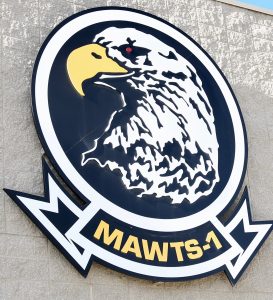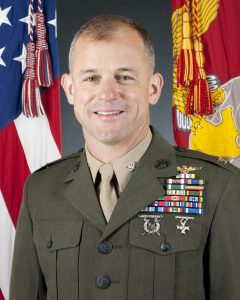2016-12-17 By Robbin Laird and Ed Timperlake
During our most recent visit to USMC Air Station Yuma, we had a chance to meet with the head of MAWTS-1 and discuss the way ahead for USMC concepts of operations as seen from this key tactical innovation center.

In our book on Pacific strategy, we highlighted the key role which the Marines are playing in shaping a new concepts of operations for US forces working with the joint and coalition forces in the region.
MAWTS pilots and trainers are looking at the impact of V-22 and F-35 on the changes in tactics and training generated by the new aircraft. MAWTS is taking a much older curriculum and adjusting it to the realities of the impact of the V-22 and the anticipated impacts of the F-35.
MAWTS is highly interactive with the various centers of excellence in shaping F-35 transition such as Nellis AFB, Eglin AFB, the Navy/ Marine test community at Pax River, Maryland, and with the United Kingdom. In fact, the advantage of having a common fleet will be to provide for significant advances in cross-service training and CONOPS evolutions.
Additionally, the fact that MAWTS is studying the way the USAF trains combat pilots to be effective flying the F-22 in shaping the Marine F-35B Training and Readiness Manual is a testimony to a joint-service approach.
This is all extremely important in how MAWTS is addressing the future. An emerging approach may well be to take functions and then to redesign the curriculum around those functions.
Laird, Robbin; Timperlake, Edward; Weitz, Richard (2013-10-28). Rebuilding American Military Power in the Pacific: A 21st-Century Strategy: A 21st-Century Strategy (Praeger Security International) (pp. 258-259). ABC-CLIO. Kindle Edition.
Question: When we were last here, MAWTS-1 did not yet have its own F-35s.
Now you do.
How are working its integration with the MAGTF?
Col. Wellons: The great thing about MAWTS-1 is we run the Weapons Training Instructor course at Yuma twice a year, and as a former CO of MAWTS put it to me, WTI is where the USMC comes together every year to train for war.
We are able to do the high end training in terms of aviation support to the MAGTF.
The F-35 is integrated into every mission that we do, whether it is close air support, helicopter escort, or, at the high end, air interdiction operations against a high-end threat including integrated air defense as well.
When we come back from a typical WTI mission exercise, and we debrief it with the helo and fixed wing guys and the C2 guys and the ground combat guys, more often than not it is the F-35 which is identified as the critical enabler to mission success.
It is the situational awareness we gain from that platform, certainly when dealing with a higher end threat like dealing with air defense, that provides us with capabilities we have in no other platform.
I am pleased with where we are with the airplane right now.
We have declared IOC and we are getting to deploy it to Japan.
Question: How does the integration of the F-35 into your operations, change how you think about those operations?
Col. Wellons: A lot of that can be quickly classified but let me give you an example, which does not fall into that category.
Historically, when we could come off of L class ship with Mv-22s, CH-53s, Cobras and Harriers and we then faced a serious AAA or MANPADS threat we would avoid that objective area.
Now we do not need to do so.
It changes the entire concept of close air support.
In Afghanistan and Iraq we have not had prohibitive interference in our air operations.
With double digit SAMS as part of threat areas we are likely to go, the F-35 allows us to operate in such areas.
Without the presence of the F35, it would be a mission that we wouldn’t be capable of executing.
The SA of the airplane is a game changer for us.
Rather than getting input from the Senior Watch Officer on the ground with regard to our broader combat SA, we now have that in our F-35. This allows us to share SA from the pilot flying the airplane and interacting with his sensors. He can share that information, that situational awareness, with everybody from other airborne platforms to the ground force commander in ways that are going to increase our ops tempo and allow us to do things that historically we wouldn’t have been able to do.
The ability of the F35 to be able to recognize and identify the types of prohibitive threats that would prevent us from putting in assault support platforms and ground forces is crucial to the way ahead.
The F-35 can not only identify those threats, but also kill them.
And that is now and not some future iteration.
Question: You are innovating as well with the F-35 as you integrate with your forces.
Can you describe an example of such innovation?
Col. Wellons: Absolutely.
One example has been something we did in the last WTI class, namely hot loading of the F-35 as we have done with the F-18 and the Harriers in the past.
We worked with NAVAIR and with China Lake and Pax River and came up with a set of procedures that we can use to do the hot load of an F-35.
We did it successfully at this last WTI class, and it shortens significantly the turn time between sorties.
When you think about us operating in some places around the world we do, the number of additional sorties we can generate as a result of being able to do that, and the reduction in the vulnerability that we have in terms of the turn around is crucial.
Also whenever you shut an airplane down, whether it’s a fifth-gen airplane or a legacy airplane, it has a greater tendency to break.
We did GBU-12 last class, we’ll be doing GBU-32 and AIM-120 this upcoming class.
Question: Obviously, you are working with the USAF and the US Navy on reshaping air operations affecting the MAGTF, can you give us a sense of that dynamic?
Col. Wellons: For the USAF, the capabilities of the airplane in terms of the sensors that we have, the weapons that we have, the way that we’re employing this airplane, they’re remarkably similar.
We are in lockstep with Nellis, with the weapons school, with the 53rd Tests and Evaluation Group in terms of how we’re doing operational tasks, and we are very closely aligned with them in terms of how we employ the airplane, how we support the airplane.
We do quite a bit of work with Fallon. They are on a different timeline from the Air Force. They’re a couple of years behind in terms of where they are, but I anticipate that we’ll have similar collaboration with the Navy as they begin to lean forward into the F35 in the next couple of years.
Biography of Col. James Wellons
Colonel James B. Wellons grew up in Victoria, Virginia. He graduated from the United States Naval Academy in May of 1992, earning his commission as a Second Lieutenant in the United States Marine Corps. After completion of The Basic School and Naval Flight Training, he reported to VMAT-203, Cherry Point, NC for AV-8B Harrier training.
Colonel Wellons completed AV-8B Harrier training in 1997 and reported to the VMA-231 “Ace of Spades,” where he served in various assignments and deployed twice with the 26th Marine Expeditionary Unit, first in 1998 and again in 1999.
In March of 2000, Colonel Wellons returned to VMAT-203 for duties as an AV-8B instructor pilot and graduated from the MAWTS-1 Weapons and Tactics Instructor (WTI) Course.

In January of 2002, Colonel Wellons returned to VMA-231 as WTI and was promoted to Major. He then deployed as Future Operations Department Head for HMM-263 with the 24th Marine Expeditionary Unit from August of 2002 through May of 2003, during Operation IRAQI FREEDOM I.
In July of 2003, Colonel Wellons reported to MAWTS-1 in Yuma, Arizona for duties as an AV-8B instructor pilot. While at MAWTS-1, Colonel Wellons served as AV-8B Division Head and TACAIR Department Head; he also flew as an adversary pilot in the F-5E with VMFT-401.
In June of 2006, Colonel Wellons reported to the School of Advanced Air and Space Studies (SAASS) at Maxwell Air Force Base, AL, graduating in June of 2007 with an M.A. in Airpower Art and Sciences. Upon graduation, Colonel Wellons reported to Marine Corps Forces Central Command (MARCENT) for duties as an operational planner. While at MARCENT he was promoted to Lieutenant Colonel.
In August of 2009, Colonel Wellons reported to Eglin Air Force Base, FL, where he stood up and commanded VMFAT-501, the F-35B Fleet Replacement Squadron. In February of 2012, Colonel Wellons relinquished command and reported to the U.S. Naval War College, in Newport, RI, where he graduated with highest distinction in March of 2013 with an M.A. in National Security and Strategic Studies.
In March of 2013, Colonel Wellons reported to U.S. Southern Command in Doral, FL for assignment as Executive Officer to the Commander. He was promoted to Colonel during this tour.
In June of 2015, Colonel Wellons reported to Marine Aviation Weapons and Tactics Squadron One, where he assumed command in May of 2016.
Colonel Wellons has held qualifications in the AV-8B, F-5E/F, and F-16C/D. His decorations include the Defense Superior Service Medal, Meritorious Service Medal with gold star in lieu of third award, Air Medal, Navy and Marine Corps Commendation Medal, and various unit and campaign awards.
http://www.29palms.marines.mil/Leaders/Leaders-View/Article/792387/col-james-b-wellons/
Also, see Todd Miller’s recent interview aboard the USS America with the USMC F-35 pilots where they discuss their F-35 experiences:
The Moment Pilots First Realized the F-35 was Something Extraordinary

